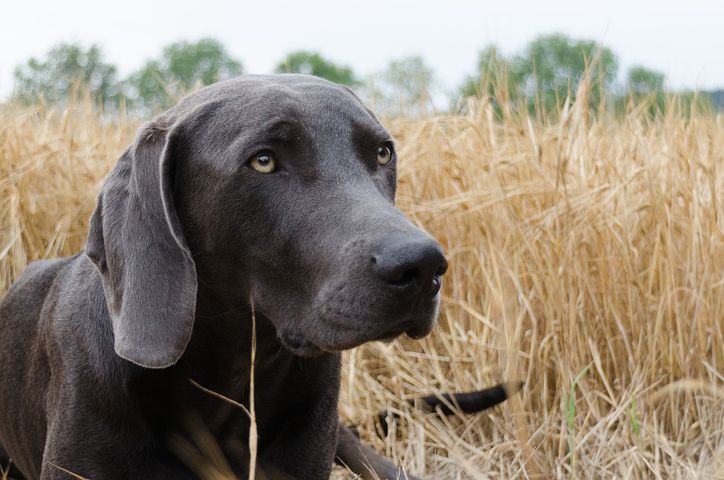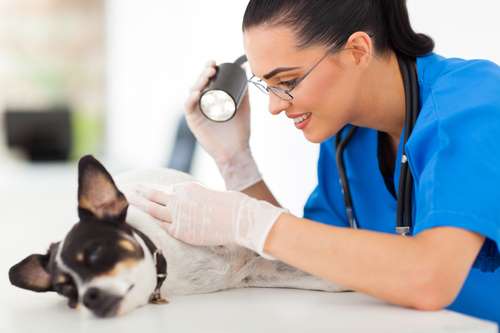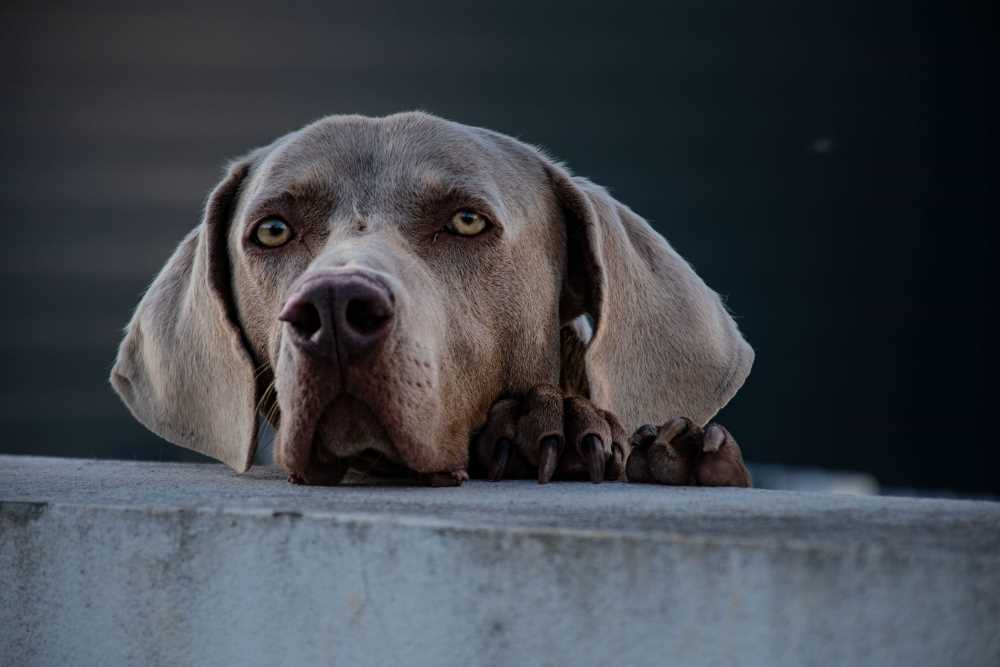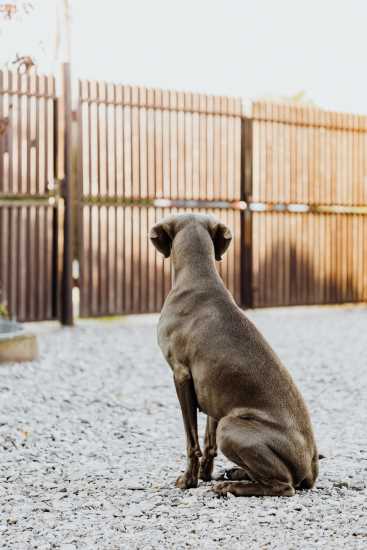Even though dog cancer treatment has made great strides in recent years, we still do not have a single and complete cure for cancer in dogs and cats.
With no single best treatment for the varied kinds of canine cancer, your vet may use a variety of approaches to get the best result.
Whether your dog has a good chance for survival and recovery, will depend on the kind of cancer that she has and how quickly the cancer is discovered.

In this article I will discuss:
- Difficult decisions about dog cancer treatment
- Cost of dog cancer treatment
- What is the difference between benign and malignant tumors?
- Types of cancer treatment available to dogs
- Your role in cancer treatment for your dog
- What if there is no cure?
Difficult Decisions about Dog Cancer
Aside from cost, there are some really tough questions to consider if your dog has cancer. You will need to make decisions, based on the kind of cancer that your dog has, your dog’s age and general health, and whether your vet believes that your dog can make a full or partial recovery.
Decisions about cancer treatment are laden with guilt. So try to keep in mind that you need to consider both your dog’s comfort and quality of life, and whether you should prolong his life so that you will have more time to be with him.
Treatment for your dog’s cancer will be based on:
Type of Cancer
Some cancers are much easier to attack and have a much better prognosis for recovery.
How advanced is the Cancer?
Your vet will assign a number for the stage of the cancer. Cancer goes from Stage I to Stage V, depending on how large the area affected and if the cancer has spread.
Stage V is the most serious and the least likely to respond to treatment.
Your Dog’s Age
Younger and healthier dogs tend to recover much faster and more often than older dogs who have other medical conditions.
How Sensitive is your Dog?
If your dog has trouble dealing with pain or discomfort, putting him through a number of medical procedures, hospitalizations and anesthesia could be difficult for both of you.
Is an Oncologist Involved?
An oncologist will usually recommend doing everything possible to treat cancer aggressively. Treating cancer is what an oncologist does. They are specialists and tend to offer more treatment than a generalist veterinarian.
Keeping that in mind, it’s possible that your decisions would be better made with your dog’s regular veterinarian. She knows your dog’s history and your feelings about treatment.
How Much Discomfort will your Dog Experience?
Make sure that you understand what your dog will have to go through. If the treatment is difficult, you need to consider that when you make decisions about proceeding.
Cost of the Treatment
While we like to think that we would do anything to help our pets, the simple truth is that some treatments are very costly.
How Much Does Dog Cancer Treatment Cost?
The cost of dog cancer treatment can rival the cost of treating people with cancer. If you did not purchase a pet insurance policy with a “cancer endorsement” clause before your dog was eight years old, you may be paying for cancer treatment out of pocket.
Costs will vary, depending on where you live, whether your dog is being treated by an oncologist (cancer specialist) and what treatments are being recommended.
For example, if your dog gets chemotherapy, you can expect to pay well over $1000. If she receives other kinds of treatment, the number goes up substantially, sometimes well into the thousands of dollars.
What is the Difference Between Benign and Malignant Tumors?
When your vet suspects a cancerous tumor, they will probably check to see if it is benign or malignant.
A benign tumor has well-differentiated cells that divide and reproduce a little faster than normal cells. It is slow growing and does not spread to other parts of the body.
Benign tumors do not threaten your dog’s life unless the get really large and press on a body organ. The one exception is when the tumor is on a gland and it alters the hormones of your dog’s body. An example of this is Cushing’s disease.
On the other hand, a malignant tumor grows rapidly and it can spread to other parts of the body.
Cancerous tumors often spread by sending out finger-like projections into the surrounding tissues. They are hard to remove surgically.
A malignant or cancerous tumor will grow and spread until the cancer kills the dog or until every malignant cell is removed or destroyed.
Types of Cancer Treatment
When your vet recommends a treatment for your dog, she will consider the type of cancer, how quickly that cancer grows and spreads and where in your dog’s body the cancer is located.

Your vet will recommend one treatment or a combination of treatments, based on your whether your dog has a good chance for recovery and on whether you can afford to pay for the treatments.
Surgery for Dog Cancer
Surgery is the oldest dog cancer treatment. Also the simplest treatment, the vet just cuts out the tumor or amputates the leg affected by bone cancer.
The goal with surgery is to remove all the cancerous cells. If the cancer is discovered early, this is possible.
Surgery is most effective when the cancer has not yet spread. If there is any doubt about getting all the cancerous cells, your vet may suggest another treatment, in addition to surgery.
Sometimes a vet will remove an unsightly tumor that is benign, to improve your dog’s appearance, or a tumor that is pressing on a vital organ and affecting your dog’s body functions.
Radiation Therapy for Canine Cancer
Radiation therapy is often used when the cancer has not spread to other parts of your dog’s body or as a way to get any cancerous cells that the surgery missed. Treatment with radiation is often used together with chemotherapy.
Radiation works as a treatment because cancer cells do not recover after being irradiated, while healthy cells near the cancer do recovery.
When your dog gets radiation, it does not hurt during the treatment, but it can be very painful later, after the treatment. Healthy cells are damaged and need to recover.
Radiation treatment does need to be administered in small doses. Your dog may receive treatment anywhere from once a day for three weeks to every other day for four to six weeks.
There are some side effects with radiation. Your dog may experience tissue death, his organs may be affected or he can become blind.
Chemotherapy as Dog Cancer Treatment
When your dog takes drugs that destroy cancer cells, it is called chemotherapy. With chemotherapy the goal is to shrink a tumor, stop the cancer’s growth or destroy the cancer
Your vet will decide whether to use chemotherapy, based on the kind of cancer, your dog’s general health, the stage of the cancer and whether you can afford the expensive medications.
Chemotherapy is often used to kill rapidly dividing cells that have spread to several areas of your dog’s body.
Ideally the drugs used would kill the cancer and leave your dog’s health intact.
However, like radiation, chemotherapy does affect your dog’s normal healthy cells. The drugs simply destroy the cancerous cells more quickly than the healthy ones.
If you go this route with your dog, she may take the medications by mouth, intravenously, or through injections.
Side Effects from Chemotherapy
Most dogs have some side effects from chemotherapy. Some dogs lose their hair, but this is not as common as we see in humans.
Side effects from chemotherapy range from nausea to death. Here are some that you might see in your dog:
- Hair loss – mostly in breeds that have continually growing hair like Bichon Frises, poodles and some terriers like miniature schnauzers.
- Nausea
- Vomiting
- Diarrhea
- Fatigue
- Lack of interest in food
- Anemia – reduction in the red blood cells
- Leukopenia – reduction in white blood cells. If this happens, your dog will not be able to fight infections easily.
- Low platelet count – Platelets are the cells that clot blood. When they are low, your dog is at risk of serious bleeding.
- Death from the chemotherapy – estimated to be less than 5% of dogs undergoing chemotherapy
Your Responsibilities for your Dog’s Cancer Treatment
Treatment for a dog with cancer is a team effort, including you and the vets involved. As the primary care person for your dog, you will have some responsibilities.
- Giving medications
- Post-surgical wound care if your dog has surgery
- Recognizing the symptoms of pain in your dog – Since you see your dog every day, you are in the best position to know if she is having pain.
- Making sure your dog is comfortable and clean
- Nutrition – Dogs with cancer have special nutritional needs.
What if there is No Cure?
Unfortunately not all cancers can be cured, and not all cancer treatments are successful. In some cases most of the cancer is gone, but it returns later.
Treatment for the cancer may cause a lot of pain for your dog or it may cause significant side effects, without any hope for curing the cancer.
At some point, you may need to consider whether continuing the cancer treatment is wise or whether it makes your dog so miserable that simply letting her go is more compassionate. It becomes a choice between a longer life in pain and misery or a shorter life in less pain and discomfort.
Discontinuing Treatment
If you decide to discontinue the treatments, your focus will shift to providing comfort and nurturing care for your dog in her final months or days. It’s like Hospice care for people.
Keep in mind that taking care of a dying pet can be stressful for you, as well. Your dog may become incontinent of urine and his bowels. And the level of care that you will need to provide will increase as your dog nears the end.
Making Your Pet Comfortable
In addition to providing a comfortable environment for your dog, you will need to look at ways to relieve pain. Providing a safe, stress-free environment is important for your dog. Make sure your pet has a comfortable orthopedic bed with good support.
Even if your dog has adjusted to changes well in the past, long trips in the car or stays at the kennel can be traumatic and stressful now. This may be the time to reduce the number of visits to the vet, as that can be stressful, as well.
Spend as much time as you can with your dog now. You will be able to react to his needs and it will also give you time to say your good-byes and prepare yourself emotionally for the inevitable.






Leave a Reply